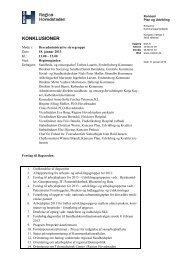Territorial Review Copenhagen - Region Hovedstaden
Territorial Review Copenhagen - Region Hovedstaden
Territorial Review Copenhagen - Region Hovedstaden
You also want an ePaper? Increase the reach of your titles
YUMPU automatically turns print PDFs into web optimized ePapers that Google loves.
229<br />
3.4 Political leadership<br />
The City of <strong>Copenhagen</strong> is run according to a modified Committee rule,<br />
with shared responsibility for the administration. The city government of<br />
<strong>Copenhagen</strong> consists of the City Council and seven committees: a finance<br />
committee and six sectoral committees, each with its own area of<br />
responsibility. The city‘s supreme political authority is the City Council,<br />
which consists of 55 members, each elected for a four-year period. The City<br />
Council lays down the guidelines for the work performed by the committees<br />
and the administrations. The Lord Mayor presides over the Council‘s<br />
meetings. The Finance Committee consists of 13 members of the City<br />
Council and is chaired by the Lord Mayor. The six chairmen (called mayors)<br />
from the six sectoral committees are ex officio members of the Finance<br />
Committee, along with six other members of the City Council.<br />
The Lord Mayor has no right to instruct the six mayors, and the mayors<br />
of the seven administrations are on equal footing. The members of the<br />
sectoral committees are apportioned in proportion to the size of the political<br />
party in the City Council to which they belong. The Lord Mayor and the six<br />
mayors are full-time politicians and are elected for a four-year period by the<br />
City Council proportional to the political party to which they belong. This<br />
means that not all of them belong to the majority of the City Council. The<br />
administration of the City of <strong>Copenhagen</strong> is divided into seven<br />
administrations, and the responsibility for the administrations is shared by<br />
the Lord Mayor and the six mayors, each within their committee-area.<br />
This model is one of three government models that are allowed for<br />
municipalities, all embedded in a strong tradition of involving political<br />
minorities. Minority influence in the City of <strong>Copenhagen</strong> is attained through<br />
the minority‘s participation in the mandated sectoral committees (such as<br />
education, social services, culture etc.) and by the fact that the committee,<br />
not the Lord Mayor or the mayors, is responsible for running the services.<br />
The Lord Mayor and the mayors are only responsible for the administration<br />
of each of their committee-areas. In the normal Committee rule, adopted in<br />
most Danish municipalities, the responsibility for the administration is not<br />
shared, and they have no right to more than one full-time politician: the Lord<br />
Mayor. In the Magistrate rule, the responsibility for providing services and<br />
the responsibility for the administration is shared between the Lord Mayor<br />
and a number of councillors (five councillors in Aarhus), elected by the City<br />
Council among the members of the City Council for a four-year period and<br />
in proportion to the size of the political party in the City Council to which<br />
they belong. The principles underlying these government models presuppose<br />
a high degree of consensus concerning the issues and that the nature and

















